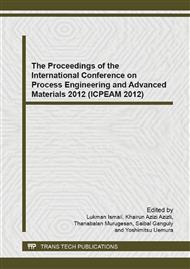[1]
National Paint & Coatings Association. Industry Info, 1999, www. paint. org/ind_info/ [Assessed: May , 2012].
Google Scholar
[2]
Cohen, E.D. and E.B. Gutoff, 1992. Modern Coating and Drying Technology, Vol. 1, Interfacial Engineering Series, VCH Publishers, Inc., New York.
DOI: 10.1080/07373939408959988
Google Scholar
[3]
Robert, A.A. , 1983. Physical Chemistry, Wiley, 6th ed.
Google Scholar
[4]
Blunk, R.H. J. and J.O. Wilkes, 2001. Surface-tension driven flows of coatings: bondline readout formation. J. Coat. Technol., 73(918): 63-71.
DOI: 10.1007/bf02698025
Google Scholar
[5]
Eres, M.H., D.E. Weidner and L.W. Schwartz, 1991. Three-dimensional direct numerical simulation of surface tension gradients effects on the leveling of an evaporating multicomponent fluid. Langmuir, 14(4): 1849-1871.
DOI: 10.1021/la980414u
Google Scholar
[6]
Evans, P. L., W. L. Schwartz and R.V. Roy, 2000. Mathematical model for crater defect formation in a drying paint layer. J. Colloids Interface Sci., 227: 191-205.
DOI: 10.1006/jcis.2000.6877
Google Scholar
[7]
Heiple, C. R. and J.R. Roper, 1982. Mechanism for minor element effect on GTA fusion zone geometry. Weld. Res. (Miami), 61(4): 97-102.
Google Scholar
[8]
Oreper, G. M. and J. Szekely, 1984. Heat-flow and fluid-flow phenomena in weld pools. J. Fluid Mech., 147: 53-79.
DOI: 10.1017/s0022112084001981
Google Scholar
[9]
Schutzius, T. M, M. Elsharkawy, M.K. Tiwan and C.M. Megaridis, 2012. Surface tension confined (STC) tracks for capillary-driven transport of low surface tension liquids. Lab on a chip- minia. Chem. and Bio., 12(24): 5237-5242.
DOI: 10.1039/c2lc40849j
Google Scholar
[10]
Zacharia T. and S.A. David, 1993. Heat and fluid flow in welding; in Mathematical Modeling of Weld Phenomena, Cerjak, H. and Easterling, K. E. (eds, The Institute of Materials, London, ), pp.3-23.
Google Scholar
[11]
Davey, N. and A. Neild, 2011. Pressure-driven flow in open fluidic channels. J. Coll. Inter. Sci., 357(2): 534-540.
DOI: 10.1016/j.jcis.2011.02.022
Google Scholar
[12]
Hu, B. and S.L. Keiweg, 2012. The effect of surface tension on the gravity-driven thin film flow of Newtonian and power-law fluids. Comp. and Fluids, 64: 83-90.
DOI: 10.1016/j.compfluid.2012.05.009
Google Scholar
[13]
de Souza Mendes, P.R., F.H. Marchesini and P.R. Varges, 2011. Gravity-driven azimuthal flow of a layer of thizotropic fluid on the inner surface of a horizontal tube. J non-Newtonian Fluid Mech. 166(17-18): 1004-1011.
DOI: 10.1016/j.jnnfm.2011.05.009
Google Scholar
[14]
Orchard, S.E., 1962. On surface leveling in viscous liquids and gels, " Appl. Sci. Resea. Sect. A, 11: 451 – 464.
Google Scholar


